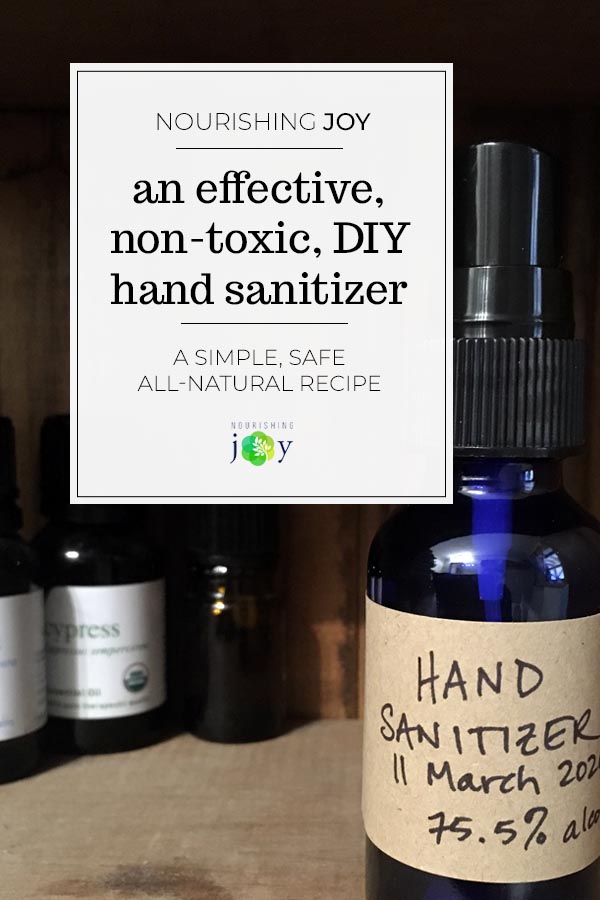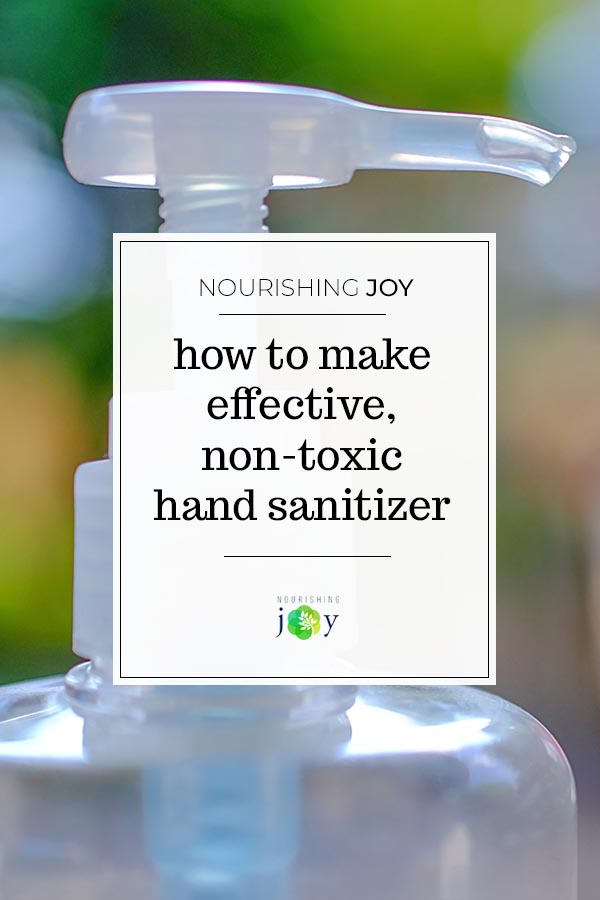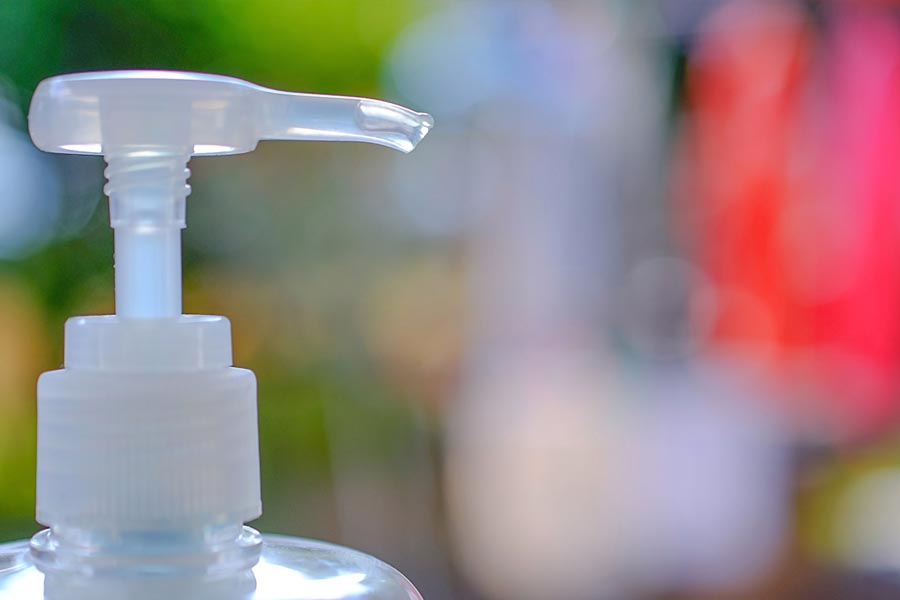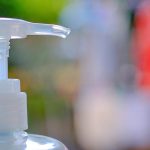A SAFE and Effective DIY Hand Sanitizer Recipe
This post may contain affiliate links, including those from Amazon.com, which means we earn a small commission off your purchases. And here's the thing: We only mention services and products that we think are truly worth your attention, whether they're free, paid, or otherwise. This site relies on YOUR trust, so if we don't stand behind a product 110%, it's not mentioned. Period.

As you know, I am a hard-core DIYer, especially when it comes to natural health and personal care.
I'm also an ardent proponent of natural alternatives to conventional health products, as this site is testament to. I have experienced and witnessed the power of natural remedies firsthand and long for the world to recognize the amazing power of herbs, essential oils, clay, and other natural remedies. <3
So it may come as a surprise that I am recommending that you pause before you make your own hand sanitizer during this time when hand sanitizer is hard to come by and it's oh-so-needed. After all, making smart DIY versions of natural health staples is my bread and butter – it's what I do and want you to do too!
So why would I suggest that you stop?
To answer that question, let's remind ourselves why we use hand sanitizer in the first place.
The purpose of hand sanitizer is to disinfect our hands from any pathogens that may be clinging to them. We pick up viruses, bacteria, and other microbes everywhere we go, so it's important and necessary to annihilate these assailants before we touch our faces or lay hands on anything that's going to go in our mouths.
This is elementary, right?
But notice I said “to annihilate” rather than “to rid” our hands of the microbes. This is why washing hands is the BEST way to get them clean – by scrubbing hands (which loosens the microbes) with soap (which binds to the microbes) under running water (which carries the microbes away), we RID our hands of the offenders. Yet when we use hand sanitizer, it just kills the microbes (or at least most of them), but they're still there on our hands.
And this is the crux of why it's so important to use a hand sanitizer that ACTUALLY KILLS the microbes (and in the case of viruses, breaks down the hard outer shell of the virus, rendering it incapable). If they're not dead, they're still going to be either live and viable when they go in your mouth or hand something to someone who is immunocompromised OR only the really strong microbes will remain, which means it's possible that only the strong ones will replicate and soon we could be faced with pathogens that seemingly can't be killed (this is referred to as “microbial resistance”).
To learn more, read Show Me the Science: Hand Sanitizers, including the linked studies at the bottom of the article.
So, how can you KNOW that your hand sanitizer is strong enough and SAFE to use?
According to the Center for Disease Control and the World Health Organization, a hand sanitizer must include alcohol AND be at least 60% alcohol by volume in order to sufficiently kill pathogens present on the hands.
(Interestingly enough, however, if the alcohol content is more than 92%, it isn't as effective as a 70% solution. Read more here.)
Now, ironically, I have argued in the past that a good DIY hand sanitizer shouldn't use alcohol at all because it is too drying to the skin and because alcohol is indiscriminate in what it kills – meaning, it kills the good bacteria as well as the bad and wouldn't we want the good bacteria to remain? However, in this case, that was both poor logic and bad science on my part, simply because while creating a welcome environment for good bacteria to proliferate may work well to produce a gorgeous vat of sauerkraut over the course of 10-15 days, it's simply not true when it comes to pathogens and bacteria on the skin and there are multitudes of studies demonstrating how the good bacteria readily repopulate following alcohol application.
Also, part of the reason the CDC and WHO recommend alcohol for disinfection is that alcohol has “fast acting and broad-spectrum activity, excellent microbicidal characteristics, [and] lack of potential emergence of resistance.” (Source: WHO Guidelines on Hand Hygiene in Healthcare, PDF)
There aren't many (if any) other substances – not even some essential oils – that can fit that profile.
So, I am forced to admit that alcohol – and plenty of it – is an absolutely necessary part of an effective hand sanitizer.
And this is one of two reasons that most DIY hand sanitizers go astray. If you're mixing standard 70% rubbing alcohol with any other ingredients, such as aloe vera, you're likely creating a hand sanitizer that is far below the safe value.
“But what about those essential oils you just mentioned?” you say. “Aren't they antiviral, antibacterial, and antimicrobial? Don't they kill the pathogens?”
Well, yes, quite effectively, in fact – BUT….
BUT – and this is a big “but” – the problem is that since the active constituents in essential oils vary (sometimes greatly) between batches, between brands, between harvest years, between subspecies, between the countries in which they were grown, you simply cannot include them in your calculations for exactly how potent or how effective your DIY hand sanitizer recipe is.
Also, each type of essential oil affects different types of viruses/bacteria/microbes differently, so unless you're going to look specifically at how a certain strain of oregano affects a specific strain of herpes or a specific coronavirus or a specific influenza, you can't safely assume the impact that essential oil will have.
The best you can say is “[Such-and-such] essential oil is a potent antiviral….”
You CANNOT safely say, “[Such-and-such] essential was shown in XYZ study to kill 90% of [specific strain of virus], so if I use it in my DIY hand sanitizer, it will kill 90% of the viruses.” There are at least three invalid assumptions in that statement alone that would render your hand sanitizer unsafe!
(As much as it pains me to say it – I would love for essential oils to be an automatic panacea for everything every time. ::sigh:: )
Better said, essential oils ABSOLUTELY will act as antiviral, antibacterial, and antimicrobial agents – you simply don't know how much, so you can't use them in your calculations.
So, yes, include them in your recipes.
Yes, love them.
But unless you have a way to accurately test the actual potency of your finished hand sanitizer, which usually involves highly technical equipment, you can't rely on essential oils to provide the full spectrum you need to guarantee a safe hand sanitizer.
By the way, I ADORE this article on the unique way Turkey uses both alcohol and essential oils to create an effective hand sanitizer. It's one of the best things I've read all year. <3
And there's another problem with essential oils too…
As I say over and over and over in our free, 10-day essential oil safety class, if you're going to use essential oils on the skin, they MUST MUST MUST be properly diluted. Otherwise, you could end up with irritated skin or – worse – your immune system could overreact to the essential oil and never let you use the essential oil again without breaking out in a reaction (this is called sensitization).
The problem in DIY hand sanitizers is that since essential oils are not water-soluble, they tend to come out of solution if there's not enough alcohol in the recipe, so they end up on your hands in far too high a concentration. And remember: aloe vera is mostly water, so there's no way to evenly “suspend” essential oils in aloe vera, even though it looks like a gel.
(More accurately, essential oils will always eventually come out of solution with anything other than oil, but high-proof alcohols generally keep them enough in suspension to keep them safe on the skin. However, this is also why we say SHAKE, SHAKE, SHAKE before you use the hand sanitizer, to make sure everything is re-emulsified right before applying.)
So by all means use your favorite essential oils – whatever they may be – but be sure you know what each essential oil's topical maximum is before you add it to the recipe.
Here's an example: Melissa essential oil has a topical maximum of 0.5% during pregnancy. That means if your batch of DIY hand sanitizer has a total volume of just over 3/4 cup like the recipe below, you can use no more than 15 drops of Melissa in the batch. (That drop count accounts for the total batch volume as well as the topical maximum, calculated using the drop size average.)
If you need a way to look up topical maximums, as well as essential oil properties and oil-specific safety guidelines, our in-depth Essential Oil Binder provides 300+ pages of reference info and printables to use and organize your essential oils. <3
So, before we get to the formulation for a DIY hand sanitizer based on the WHO guidelines for hand rubs, I promised two things in this article:
- HOW to check whether your DIY hand sanitizer is safe
- What to do if it's not safe
So, #1. Here's how you check if your DIY hand sanitizer is safe: go back to the recipe you used when you made it. Look at the proportions of the ingredients and if there's not at least 60% alcohol present by volume, then you should consider the hand sanitizer unsafe.
Be especially suspicious if your recipe simply calls for “rubbing alcohol.” If the author of a recipe doesn't take the time to specify which concentration of rubbing alcohol to use, the recipe is very likely unsafe.
And keep in mind – alcohol can show up in all sorts of different forms. Your recipe might call for vodka, witch hazel, rubbing alcohol, Everclear… each of these has vastly different amounts of alcohol. Vodka tends to range from 40-50%, witch hazel tends to be about 12-15%, Everclear can easily be 70-90% – my point is, simply know what you're working with.
If you were GIVEN the hand sanitizer, go back and ask the person who gave it to you, if you can.
And #2. If you realize your hand sanitizer is unsafe, you have a couple of options. If you can easily calculate how to add the sufficient amount of alcohol, you can just remix the batch – thankfully DIY hand sanitizers tend to be fairly forgiving in their textures.
Another option is to make a new batch by following the formulation below.
If you don't want to waste the mixture you have, perhaps repurpose it as a freshening-up counter spray or upholstery spritz. It won't kill all the bacteria on those surfaces, but it will certainly provide a welcome boost to whatever cleaners you already use.
So, if you do need or want to make your own hand sanitizer, here is one recipe that I created based on the formulations as published by the World Health Organization (I say “based off of” because their smallest formulation makes 10 liters at a time). I've added my own favorite essential oils to their basic recipe, but you may switch these essential oils out for your own favorites, if desired, keeping in mind the topical maximums, of course.
And let's take a quick look at why each ingredient is included here:
Isopropyl Alcohol (70% or 91%) – As we've already discussed, this is the ingredient that is responsible for the disinfection and antisepsis, aka “the microbe assassin.” ?
Hydrogen Peroxide (3%) – Hydrogen peroxide is great for cleaning wounds, but it's included here not for disinfecting the skin, but for disinfecting the hand sanitizer mixture itself, just in case any cruddies made their way into the mix before it was made.
Glycerin – Glycerin is a humectant and keeps your hands from feeling so dried out after using the hand sanitizer. (Definitely a welcome addition.)
Ravensara Essential Oil – Ravensara has long been prized for dealing with viral infections, particularly those of a respiratory nature.
Tea Tree Essential Oil – Tea Tree is not only easy to find and inexpensive to purchase, but a number of studies have pointed out that it is unique in its broad-spectrum antimicrobial activity.
Thyme Essential Oil – The linalool chemotype of Thyme offers great antimicrobial support, but is also gentle on the skin.
Lemon Essential Oil – Not only is Lemon antimicrobial, it leaves behind a clean, fresh scent and can help stimulate and boost the immune system.
Cape Chamomile Essential Oil – Cape Chamomile is not only extremely calming, like all chamomile oils, but it is a dazzling blue color, so it adds a fun hue to your DIY hand sanitizer, especially if you pour your hand sanitizer into a clear spray bottle. (You may substitute the other blue chamomile oil, German Chamomile, if no one who will use the hand sanitizer takes any medications, due to possible drug interactions.)
If your local supplier is out of any of these ingredients or you like the convenience of ordering online, here's where you can find any or all of these items:
- Click here to buy Ravensara essential oil at Lotus Garden Botanicals, a quality perfumerie and aromatherapy supplier
- Aromatics International offers all of the rest of essential oils (including the hard-to-find Cape Chamomile!). Click the link above to visit the site and get a $10 coupon code good for your first order.
- These glass spritz bottles come with a mini-funnel and scrub brush, which makes them super-easy to fill and clean for a second (third, fourth…) use.
- Glycerin can be hard to find, but here's a good glycerin at Amazon
- Click here to buy isopropyl alcohol at Amazon
- Click here to buy hydrogen peroxide at Amazon
DIY Hand Sanitizer
Ingredients
using 70% isopropyl alcohol - finished hand sanitizer contains approximately 63.5% alcohol
- 13/16 cup isopropyl alcohol, 70% - this is 3/4 cup plus 1 tablespoon
- 2 teaspoons hydrogen peroxide, 3%
- 1 teaspoon glycerin
- 20 drops Ravensara (Ravensara aromatica) essential oil
- 20 drops Thyme (Thymus vulgaris) essential oil, linalool chemotype
- 20 drops Cape Chamomile (Eriocephalus punctulatus) essential oil
- 10 drops Tea Tree (Melaleuca alternifolia) essential oil
- 10 drops Lemon (Citrus limon) essential oil
using 91% isopropyl alcohol - finished hand sanitizer contains approximately 75.5% alcohol
- 13/16 cup isopropyl alcohol, 91% - this is 3/4 cup plus 1 tablespoon
- 2 teaspoons hydrogen peroxide, 3%
- 1 teaspoon glycerin
- 20 drops Ravensara (Ravensara aromatica) essential oil
- 20 drops Thyme (Thymus vulgaris) essential oil, linalool chemotype
- 20 drops Cape Chamomile (Eriocephalus punctulatus) essential oil
- 10 drops Tea Tree (Melaleuca alternifolia) essential oil
- 10 drops Lemon (Citrus limon) essential oil
- 4 teaspoons distilled water
Instructions
- In a pint-sized lidded glass jar, gently swirl together the isopropyl alcohol and the hydrogen peroxide. Add the glycerin and essential oils, screw on the lid, and shake or swirl gently until the glycerin is dissolved.
- If using 91% isopropyl alcohol, add the 4 teaspoons distilled water and swirl again.
- Divide the mixture evenly between two clean 4-oz spray bottles using a pipette or a mini-funnel to prevent spills. (Each bottle will be between 3/4 and 7/8 full.)
- Screw on the caps, then label the bottles, including the date on which you've made the sanitizer. Let the bottles sit for 72 hours before use to allow time for any spores or other contaminants within the mixture to be destroyed.
- To use, shake well, then spritz generously on your hands and rub over all sides and surfaces of your hands. Rub until hands are dry.
- Cautions: Do not spray on the face or near the eyes. Keep out of the reach of children.
Notes






